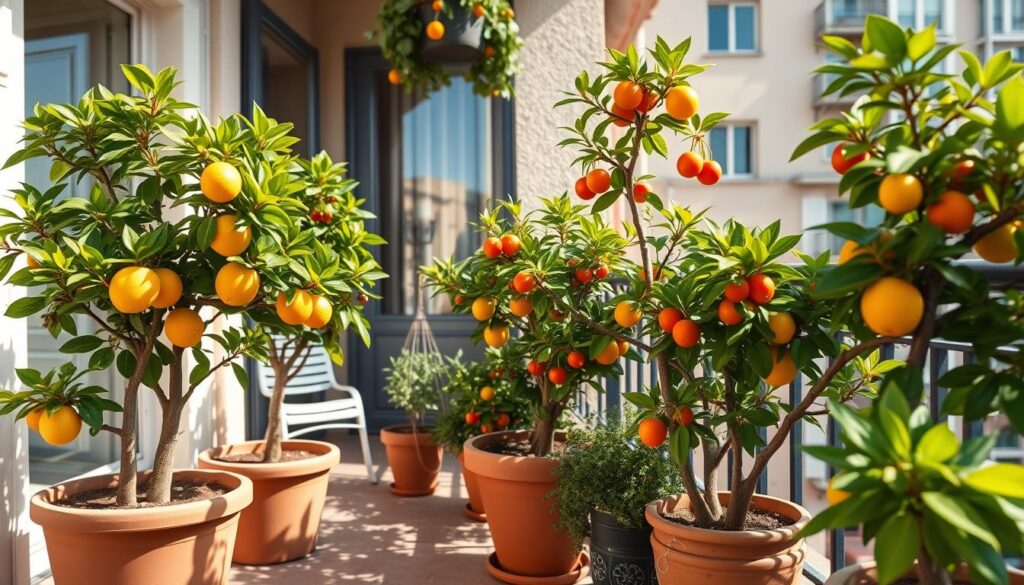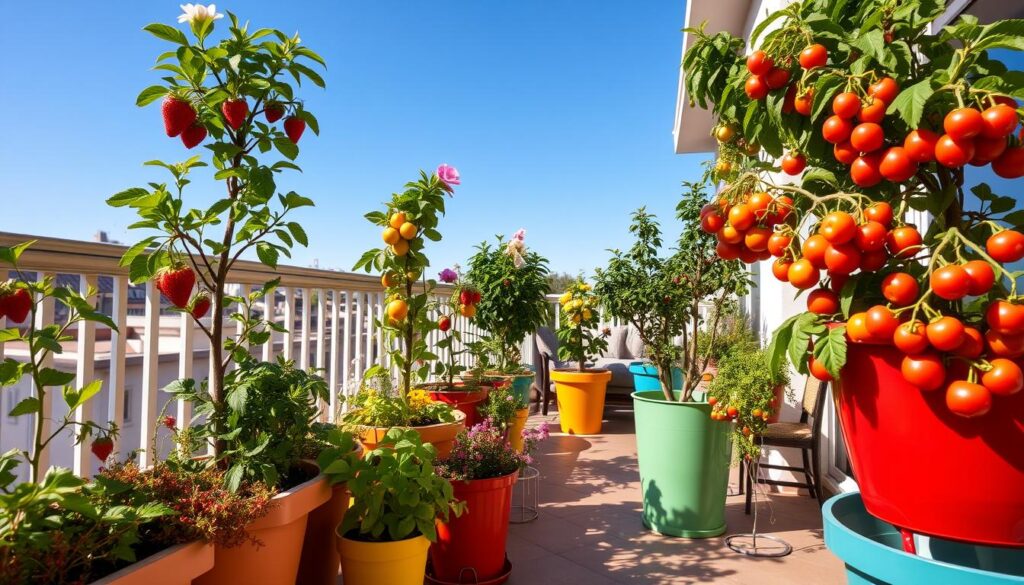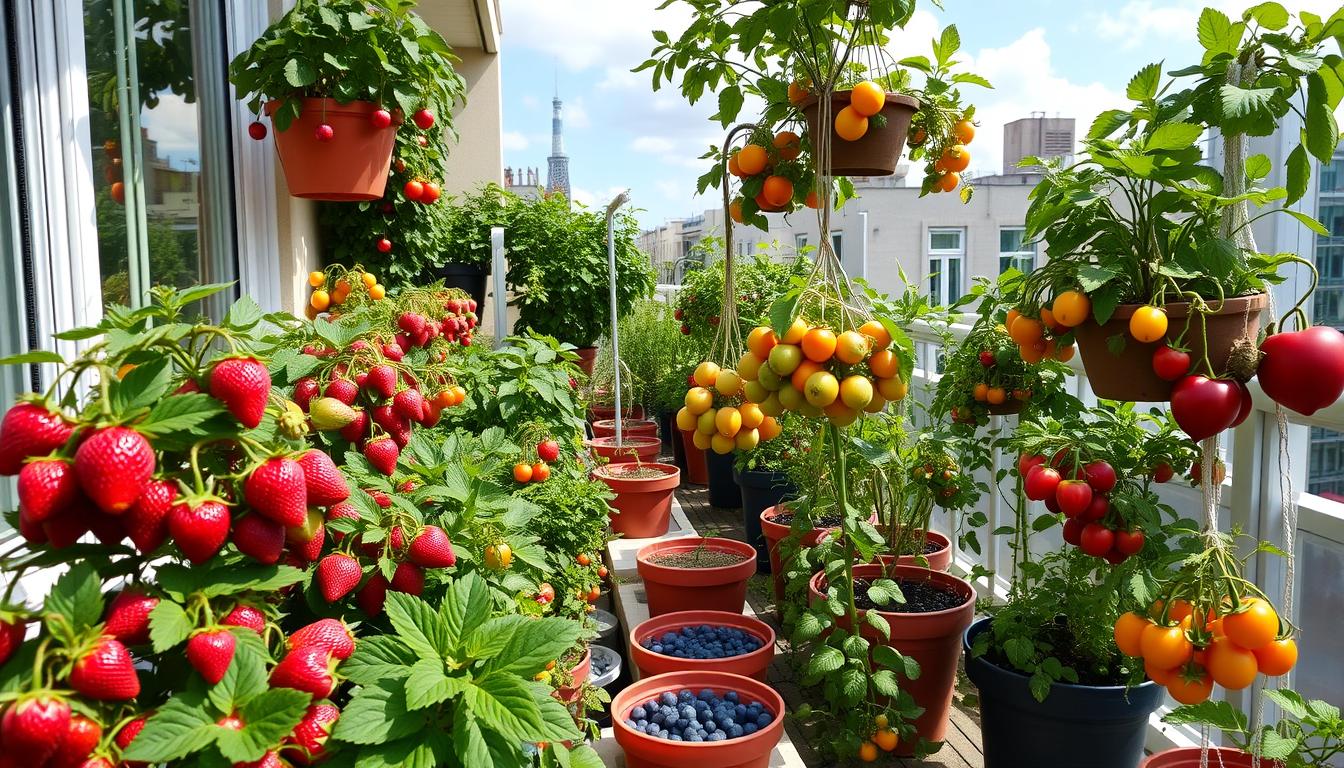Urban living spaces are getting smaller, but people are still keen on gardening. Growing fruits on your balcony is a great way to use space and add greenery. I’ve found many fruits that do well in small areas, perfect for city gardens. This article will show you the top 5 balcony fruits and give you tips on caring for them.
Key Takeaways
- Balconies are ideal for fruits, including strawberries and tomatoes.
- Dwarf fruit trees, like cherries and peaches, thrive in small spaces.
- Using containers with proper depth is important for root vegetables and fruits.
- Climbing fruits can optimize vertical space on your balcony.
- Herbs and peppers also flourish in balcony gardening with adequate sunlight.
Introduction to Balcony Gardening
Balcony gardening is a fun way to garden in the city. It turns small spaces into green havens. You can grow all sorts of plants, like fruits, right in the city.
Starting a balcony garden means looking at how much sunlight it gets. Most plants need at least 2000 lumens of light. So, pick the best spot for your plants to get enough sun.
There are many plants you can grow, like fruits and even mushrooms indoors. Oyster mushrooms and Shiitake grow fast, in about 45 days. Balcony gardening is a great way to enjoy gardening in the city.
Benefits of Growing Fruits on Your Balcony
Balcony gardening has many benefits of balcony gardening, especially for growing fruits. It lets you have a personal space for urban fruit growing. This means you always have fresh produce ready for you.
This approach supports sustainable living and helps you eat healthier. It also means you don’t have to buy fruits with harmful pesticides and chemicals.
Growing fruits on your balcony can save you money. Organic fruits can be pricey, but growing your own is cheaper. Plus, it’s fun to harvest your own fruits.
Gardening can also make you feel better. Working with plants and nature lowers stress and helps you relax. Fruits like strawberries and tomatoes not only make your space look good but also improve the air quality.
Many fruits do well in containers, even in small spaces. This is great for city people who want to garden. Watching your fruits grow and harvest is rewarding. It connects you with nature and promotes a sustainable lifestyle.
Start your gardening journey with guides and expert advice. For more tips, check out this resource for new gardeners. Balcony gardening is more than just pretty plants. It makes you feel accomplished and improves your well-being.
| Benefit | Description |
|---|---|
| Fresh Produce | Access to fresh, homegrown fruits right at your doorstep. |
| Cost Savings | Reduced expenses on organic fruits and vegetables. |
| Mental Well-Being | Therapeutic effects of gardening promote relaxation and reduce stress. |
| Sustainable Living | Encourages practices that reduce reliance on industrial agriculture. |
| Urban Adaptability | Fruits thrive in small spaces, making them ideal for urban settings. |
Dwarf Fruit Trees: Perfect for Small Spaces
Dwarf fruit trees are great for small gardens. They grow up to 15 feet tall and are perfect for balconies. You can grow dwarf apricots, cherries, peaches, and figs in containers.
Container gardening helps control plant growth. Meyer Lemon and Key Lime trees can grow up to 8 feet tall. Dwarf apple trees like Gala and Granny Smith are easy to care for and self-fertile.

For dwarf fruit trees to thrive, they need sun, well-draining soil, and enough water. The 5-In-1 Apple Tree is a great example of their versatility. With the right care, they can do well in small spaces.
Some popular dwarf fruit trees include the Bonfire Patio Peach Tree and the Snowbrite White Peach Tree. They are perfect for small gardens and can produce delicious fruit. For more options, check out this collection.
| Fruit Tree Type | Mature Size | Special Features |
|---|---|---|
| Meyer Lemon | 6-8 ft tall, 4-5 ft wide | Compact and flavorful fruit |
| Dwarf Apple (Gala) | 10-15 ft wide, 10 ft tall | Self-fertile, multiple varieties on one tree |
| Celeste Fig | 5-10 ft tall and wide | Ideal for pots, great flavor |
| Dwarf Peach (Snowbrite) | 10 ft tall | Delicious fruit with stunning flowers |
| Dwarf Persimmon (Fuyu Jiro) | 6-8 ft tall | Sweet fruit, ideal for jams |
Top 5 Fruits You Can Grow on Your Balcony
Growing fruits on your balcony is exciting. It lets you enjoy fresh produce at home. Tomatoes and strawberries are great choices because they’re easy to care for and give good yields.
Tomatoes: A Sunny Delight
Tomatoes love the sun, making a south-facing balcony perfect. Cherry tomatoes are great for small spaces. Use pots that are at least 30 cm wide for them to grow well.
Keep your plants dry to avoid rot. You can find a set of 2 Big Boy Tomato Plants on Amazon for about $20. It’s a good start for your garden.
Strawberries: Sweetness in Containers
Strawberries are easy to grow in containers or hanging baskets. This makes the most of your space. Use quality compost to help them grow.
Make sure the pot is at least 10 cm deep for good root growth. You can find the Albion Strawberry Live Plant at Walmart for about $18. It’s a great choice for your balcony garden.
For more tips, check out gardenbeginner.com. It can help make your balcony garden better. This way, you can enjoy tomatoes and strawberries all season.
| Fruit | Container Size | Approximate Price |
|---|---|---|
| Tomatoes | 30 cm wide | $20 (set of 2 Big Boy Tomato Plants) |
| Strawberries | Minimum depth of 10 cm | $18 (Albion Strawberry Live Plant) |
Growing Berries: Climbing Fruits for Your Balcony
When picking fruits for balcony gardening, climbing fruits like blackberries and raspberries are great choices. They do well in vertical gardens, making the most of small spaces. Using trellises or wall planters not only helps the plants grow but also makes your balcony look better.
Blackberries and Raspberries: A Vertical Garden Approach
Blackberries and raspberries are perfect for growing in containers, especially for city folks. There are special varieties like Raspberry Shortcake® and Baby Cakes® that grow well in pots. These varieties let me enjoy fresh fruit without needing a lot of space.
For them to grow well, I need to remember a few things:
- The recommended soil volume per blueberry bush in a container is five to eight gallons.
- A pot size of at least eight gallons is ideal for cane berries like blackberries and raspberries.
- A wide-rimmed container can support around three strawberry plants for every twelve inches of surface area.
- Using a 50/50 blend of high-quality potting soil and compost as a potting mix benefits container berry plants.
Keeping them healthy is key. They need regular watering, especially in summer. Blackberries and raspberries do best with daily watering when it’s hot. Fertilizing them once a year in spring keeps them healthy.
Adding blackberries and raspberries to my balcony brings joy and helps my vertical garden thrive. If you’re curious about how to manage your gardening data, check this privacy policy.
| Berry Type | Recommended Container Size | Soil Volume |
|---|---|---|
| Blackberries | 8+ gallons | 5-8 gallons |
| Raspberries | 8+ gallons | 5-8 gallons |
| Blueberries | 5-8 gallons | 5-8 gallons |
| Strawberries | 3 plants per 12 inches | N/A |
Container Gardening Essentials for Fruit
Container gardening is key for growing fruit on balconies. Choosing the right pots and knowing how to care for them is important. A well-planned container garden uses space well and helps fruits grow healthy. I’ll help you pick the best pots, soil, and share watering tips for your urban garden.
Choosing the Right Pots and Soil
Finding the right pot is crucial for growing fruit in containers. Here are some tips:
- Pots should be large, at least 12 inches in diameter and depth, for fruits like tomatoes and peppers.
- Dwarf trees, such as oranges and lemons, do well in smaller pots and still produce fruit.
- Root vegetables like potatoes and sweet potatoes need big pots to grow well.
- Vining plants, including cucumbers and squash, need large pots to grow.
Good potting soil is also key. It should hold moisture but also drain well. This helps fruits get the nutrients they need. Herbs can also grow in small containers, making sunny windows into gardens.
Watering and Maintenance Tips
Watering is very important for container gardening, especially for fruit plants. Here are some tips:
- Keep the soil moist, as fruits and veggies need plenty of water to grow big.
- Make sure plants get at least six to eight hours of sunlight a day for best growth.
- Move tender plants indoors when it gets too cold outside, below 50 degrees Fahrenheit.
Check your plants often. Some fruits, like basil and garlic greens, can grow from cuttings or store-bought bulbs. Following these tips will help your balcony garden thrive.

Fruit Plants to Consider for Your Urban Space
Urban gardening is becoming more popular. Adding *peppers* and *chillies* to your balcony brings color and flavor to your meals. These plants come in many shapes, sizes, and colors, making them perfect for small spaces.
Peppers and Chillies: Color and Flavor
Growing peppers and chillies in the city is easy with the right tips. Beginners should start with a few good varieties. Here’s what I’ve learned about growing these plants:
- Choose a container with good drainage to prevent waterlogging.
- Opt for a sunny spot on your balcony; these plants love warm temperatures.
- Use high-quality potting soil to nourish your plants effectively.
- Regularly check moisture levels and water your plants consistently, but avoid overwatering.
Here are some popular types of peppers and chillies you might consider:
| Variety | Height | Description |
|---|---|---|
| Bell Peppers | 1-3 feet | Sweet and versatile; great for salads and cooking. |
| Jalapeño | 2-3 feet | Medium heat; perfect for salsa and grilling. |
| Thai Chillies | 1-4 feet | Highly aromatic and spicy; ideal for Asian dishes. |
| Cayenne | 2-3 feet | Spicy and good for drying and powders. |
By adding *peppers* and *chillies* to my balcony, I’ve made my urban gardening better. Their bright colors and unique flavors make my cooking better. They also make my balcony look lush and inviting.
Optimizing Sunlight and Space on Your Balcony
In urban gardening, getting enough sunlight is a big challenge. It’s key to check how much sunlight your balcony gets. This is especially true for growing fruits that need lots of light.
Plants like cherry tomatoes do well, even with less sunlight. Putting them in the sunniest spots helps them grow better. For shadier balconies, leafy greens like kale and chard are great choices.
Using vertical space is smart in urban gardening. It lets more light reach the top leaves and makes the most of your space. Hanging planters or wall-mounted shelves work well. Here are some tips for using your balcony space wisely:
- Use raised beds or containers to drain excess moisture.
- Choose climbing plants that grow upwards, using stakes or trellises.
- Make use of empty wall space or shelves for multi-tiered gardens.
- Rotate plants seasonally to find the best growth conditions.
Seasonal changes, like deciduous trees losing leaves, can bring more light in winter. Gardening during these times can give you veggies like peas and root crops that like cooler weather. Also, trying different planting times can help find the best conditions for your balcony.
| Plant Type | Sunlight Preference | Examples |
|---|---|---|
| Leafy Greens | Shade | Kale, Chard, Lettuce |
| Root Vegetables | Partial Sun | Carrots, Beetroot |
| Fruit Varieties | Full Sun | Cherry Tomatoes, Peppers |
| Herbs | Full Sun to Part Shade | Basil, Mint, Rosemary |
Creating a lively balcony garden, even with little space, is possible. By using sunlight well and making the most of your space, gardening can be rewarding and productive.
Conclusion
Growing fruits on balconies is both easy and rewarding. You can grow everything from citrus fruits like oranges and lemons to small blueberries. Knowing what each fruit needs helps anyone grow fruits on their balcony. This way, you can enjoy fresh, homegrown food.
Urban gardening does more than just give you fresh fruits. It makes you more sustainable, improves your mental health, and helps you live healthier. Every little step, like growing strawberries or training raspberry canes, helps us become more self-sufficient and care for our planet.
The real joy of growing fruits on balconies is the journey, not just the end result. It’s the happiness of caring for a fig tree or enjoying a summer with tomatoes you grew. This journey connects us more to nature in the city. It makes our lives richer with delicious flavors and special memories.



Leave a Reply